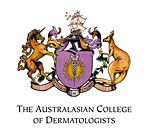A dermatologist is a qualified medical specialist who, through additional training, has obtained postgraduate qualifications to specialise in the diagnosis, treatment and prevention of skin disease and skin cancers.
One person in ten who consults a general practitioner will do so because of a skin complaint. The GP may decide to seek confirmation of a diagnosis or assistance with therapy. This is when the patient is referred to a dermatologist.
Dermatologists treat patients of all ages, from babies and children to adolescents and adults. Although diseases of the skin are many and varied, Australian dermatologists spend much of their time treating diseases caused by exposure to the sun. These include skin cancers such as basal cell carcinoma, squamous cell carcinoma and malignant melanoma.
Other potential skin problems that are part and parcel of a typical dermatologist’s work are acne, eczema, skin infections, psoriasis, occupational dermatitis, hair and nail disorders, surveillance of moles and cosmetic problems of the skin.
How do Dermatologists train?
Dermatologists are initially trained as doctors, undertaking six or more years of university study to gain their medical degrees. This is followed by several years of full-time practice and training in a teaching hospital as a junior hospital doctor. Application can then be made to enter a five-year training program in dermatology.
Prior to entering College’s training program, prospective trainees undertake additional study and scientific research in dermatology.
Early in the training program, trainees sit for the Clinical Sciences examination. Towards the end of the training program, trainees sit both written and oral components of the Fellowship examination. After passing the Fellowship examination and having completed the training program satisfactorily, a trainee is recommended for Fellowship of the Australasian College of Dermatologists (FACD).
Having gained the FACD, many dermatologists travel to dermatological centres overseas to gain post-Fellowship training or be involved in clinical and experimental research. Furthermore, dermatologists maintain their professional standards and develop new skills through participation in the College’s continuing professional development program.
What treatments are used by Dermatologists?
Advances in ultraviolet light therapy, photodynamic therapy, laser therapy and drug treatment have revolutionised dermatological therapies over the past few years.
As well, better understanding of skin diseases and skin cancers through advances in genetics, molecular biology, pathology and immunology has assisted dermatologists in the diagnosis and treatment of dermatological illnesses and cancers.
Many skin diseases can be treated with topical therapy, such as creams and lotions. However, in Australia today, surgery is widely used by dermatologists in the treatment of skin cancers, including melanomas. Radiotherapy is also utilised by dermatologists in the treatment of skin cancers.
Where do Dermatologists work?
The majority of Australian dermatologists work in metropolitan private practice. However, many provide services to rural areas on a regular basis.
Most dermatologists also conduct clinics in public hospitals. Some dermatologists also provide services at Skin and Cancer Foundations in New South Wales, Victoria and Queensland.
Dermatologists at public hospital clinics teach medical students, interns, residents and registrars. Moreover, they run courses and tutorials for general practitioners and other specialists.
Consultative services for inpatients of other specialties are also provided, in addition to management of patients admitted with more serious dermatological conditions.



